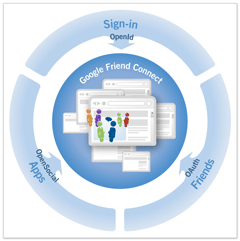Image Credits: Google
Category Archives: Freelancing & Networking
Just Google me!
 Today, Seth Godin has, once again, a good point about brand marketing.
Today, Seth Godin has, once again, a good point about brand marketing.
I noticed it myself on this blog as most of the Google searches that end on this blog use the keyword “vedovini”. To the point that next time I make business cards, instead of the usual e-mail and phone number I think I will just print “Just Google me!” under my name.
By the way, happy easter to everyone :)
5 ways to make money with software components
 Yesterday, my colleague and friend Pierre asked my opinion about whether or not people would be ready to pay 20 bucks for the right to use well crafted and well documented software components. This spawned a discussion about how to make money with software components.
Yesterday, my colleague and friend Pierre asked my opinion about whether or not people would be ready to pay 20 bucks for the right to use well crafted and well documented software components. This spawned a discussion about how to make money with software components.
Here are our thoughts for you to enjoy, comment and contribute. Have you any idea or experience do not hesitate to leave a comment.
So, what is it in a software component that can be sold?
The right to use it
Nowadays most people consider software as a commodity, free (and open source) is the rule. Even shareware looks like something of the past, you can find “donate” buttons but it seems hard to make a living of it.
Some models, like Ceki Gulcu’s Logback project (in part), consist in building commercial extensions on top of free software.
The right to distribute it
To me, the best option is dual-licensing. Let free projects use and distribute your work for free and grant commercial licenses for commercial projects.
However, the advent of SaaS is a threat to this model. The Afero GPL may help, but not much. Offering online web services may be a solution.
The right to influence the feature roadmap
I like this one, and the best example I know is Intalio’s Demand Driven Development: Let your customers bid on features they are willing to pay for.
Training
This is how jBoss started and now Marc Fleury is sunbathing in Spain (sort of). However, this works better for complex systems than for components.
Consulting
You can offer consulting around your product (like installing, configuring or extending) or use your product as a marketing tool for other consulting services. That’s what most of the component developers I know of are doing (that’s actually what I’m trying to do with the DITA-OP).
There is a sixth option but then you components may not be components anymore (depending on your definition of Software Components).
Online Web Services
Offer online services based on your components and let people pay based on their usage, much like the Amazon Web Services. This works only if you have enough customers to cover the infrastructure (hosting, support, etc).
Depending on what your components are doing and what is your target market then you can mix those revenue streams but not everything is going to always work. For example, if you have a set of highly specialized financial components you can sell licenses to use and distribute (because they are highly specialized) but you can hardly build online web services on top of them because financial institutions are not willing to use that kind of services (it can even be forbidden by local regulations).
What do you think? What else can be sold in software? How can it be sold? Do you know strange, but successful, business models?
Image Credits: Luis Miguel Munoz-Najar

Facebook connect for WordPress
It did not take long to find a Facebook Connect WordPress plugin… Continue reading
Image Credits: mkhmarketing

Is the war already over?
Some time ago I wrote that a war was coming, yesterday the strike begun. Continue reading
Image Credits: saidunsaids

Qui sait encore programmer un 68000 en assembleur?
Si vous connaissez quelqu’un et que la personne en question a un passeport Français alors j’ai peut-être un boulot pour elle.
Laissez un commentaire sur ce post ou bien contactez moi.
Image Credits: Chris Gentle

The Second Coming
Turning and turning in the widening gyre
The falcon cannot hear the falconer;
Things fall apart; the centre cannot hold;
Mere anarchy is loosed upon the world,
The blood-dimmed tide is loosed, and everywhere
The ceremony of innocence is drowned;
The best lack all conviction, while the worst
Are full of passionate intensity.Surely some revelation is at hand;
Surely the Second Coming is at hand.
The Second Coming! Hardly are those words out
When a vast image out of Spiritus Mundi
Troubles my sight: somewhere in sands of the desert
A shape with lion body and the head of a man,
A gaze blank and pitiless as the sun,
Is moving its slow thighs, while all about it
Reel shadows of the indignant desert birds.
The darkness drops again; but now I know
That twenty centuries of stony sleep
Were vexed to nightmare by a rocking cradle,
And what rough beast, its hour come round at last,
Slouches towards Bethlehem to be born
There is something coming, as opposed to Yeats I don’t think it will be the end of the civilization, but there is a war coming.
Weapons are ready and skirmishes have begun.
Image Credits: Perry French
Going-Solo is over
Going-Solo, the one-day conference organized by Stephanie Booth yesterday in Lausanne, is now over.
The conference has been filmed by Sébastien Baudet and videos are being uploaded to Dailymotion.
I must say that for a first shot it was a great one, interesting speakers, subjects that matter and a lot of useful information to grasp.
A great Bravo to Steph, big thanks to the members of the organization and lot of luck to Going-Solo. It seems that the next edition will be held in Leeds by the end of the year.
By the way, the wifi was not so bad but the microphones were no sot good ;)
Google Friend Connect Launched
Google just released a preview of their new Google Friend Connect service.
Google Friend Connect lets you grow traffic by easily adding social features to your website. With just a few snippets of code, you get more people engaging more deeply with your site.
This is not a social network by itself, this is something that enables you to turn your own web site into a social network. I can’t wait to try it myself on this blog and build my own social network…


Bootstraping communication
Last Saturday I was chatting with my colleague David about communication issues inside the enterprise. As architects, some of our objectives are to coach the development teams, publicize the architecture and the frameworks and promote new technologies. We were wondering how we could improve the communication and especially make it more fluid.
Yesterday, inspired by Twitter, I setup a Skype public chat group for the company I currently work for. This morning I sent a mail to almost everyone and started to disseminate information about the group in the corporate wiki.
And almost nothing happened, only a few people showed up and no communication occurred. I am sure this a good idea, but I think something as to actually happen to demonstrate its usefulness, may be we need to bootstrap the flow by starting to push information instead of waiting for questions to come.
Yeah, exactly like micro-blogging on Twitter :)
Image Credits: CenTerO / JaguariTech
